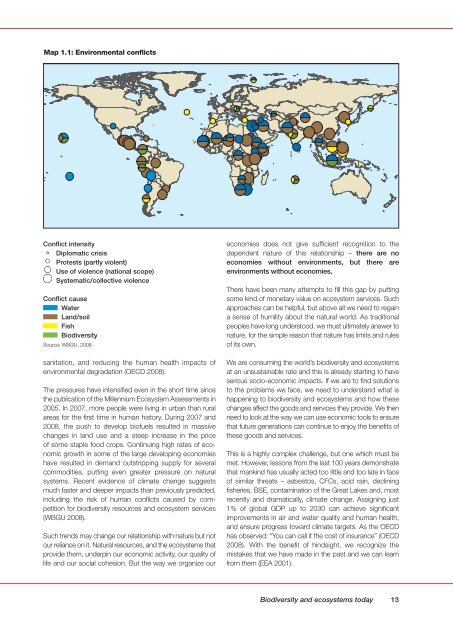Interim Report - TEEB
Interim Report - TEEB
Interim Report - TEEB
Create successful ePaper yourself
Turn your PDF publications into a flip-book with our unique Google optimized e-Paper software.
Map 1.1: Environmental conflicts<br />
Conflict intensity<br />
Diplomatic crisis<br />
Protests (partly violent)<br />
Use of violence (national scope)<br />
Systematic/collective violence<br />
Conflict cause<br />
Water<br />
Land/soil<br />
Fish<br />
Biodiversity<br />
Source: WBGU, 2008<br />
sanitation, and reducing the human health impacts of<br />
environmental degradation (OECD 2008).<br />
The pressures have intensified even in the short time since<br />
the publication of the Millennium Ecosystem Assessments in<br />
2005. In 2007, more people were living in urban than rural<br />
areas for the first time in human history. During 2007 and<br />
2008, the push to develop biofuels resulted in massive<br />
changes in land use and a steep increase in the price<br />
of some staple food crops. Continuing high rates of economic<br />
growth in some of the large developing economies<br />
have resulted in demand outstripping supply for several<br />
commodities, putting even greater pressure on natural<br />
systems. Recent evidence of climate change suggests<br />
much faster and deeper impacts than previously predicted,<br />
including the risk of human conflicts caused by competition<br />
for biodiversity resources and ecosystem services<br />
(WBGU 2008).<br />
Such trends may change our relationship with nature but not<br />
our reliance on it. Natural resources, and the ecosystems that<br />
provide them, underpin our economic activity, our quality of<br />
life and our social cohesion. But the way we organize our<br />
economies does not give sufficient recognition to the<br />
dependent nature of this relationship – there are no<br />
economies without environments, but there are<br />
environments without economies.<br />
There have been many attempts to fill this gap by putting<br />
some kind of monetary value on ecosystem services. Such<br />
approaches can be helpful, but above all we need to regain<br />
a sense of humility about the natural world. As traditional<br />
peoples have long understood, we must ultimately answer to<br />
nature, for the simple reason that nature has limits and rules<br />
of its own.<br />
We are consuming the world’s biodiversity and ecosystems<br />
at an unsustainable rate and this is already starting to have<br />
serious socio-economic impacts. If we are to find solutions<br />
to the problems we face, we need to understand what is<br />
happening to biodiversity and ecosystems and how these<br />
changes affect the goods and services they provide. We then<br />
need to look at the way we can use economic tools to ensure<br />
that future generations can continue to enjoy the benefits of<br />
these goods and services.<br />
This is a highly complex challenge, but one which must be<br />
met. However, lessons from the last 100 years demonstrate<br />
that mankind has usually acted too little and too late in face<br />
of similar threats – asbestos, CFCs, acid rain, declining<br />
fisheries, BSE, contamination of the Great Lakes and, most<br />
recently and dramatically, climate change. Assigning just<br />
1% of global GDP up to 2030 can achieve significant<br />
improvements in air and water quality and human health,<br />
and ensure progress toward climate targets. As the OECD<br />
has observed: “You can call it the cost of insurance” (OECD<br />
2008). With the benefit of hindsight, we recognize the<br />
mistakes that we have made in the past and we can learn<br />
from them (EEA 2001).<br />
Biodiversity and ecosystems today<br />
13

















